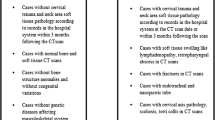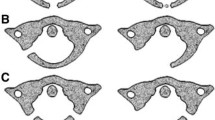Abstract
Background
We investigated the sex-specific differences in ossification patterns of the first two cervical vertebrae in Chinese children.
Methods
A retrospective computed tomography (CT) study was performed between June 2016 and December 2020. Patients younger than 16 years with cervical CT images acquired ≤ 1.5 mm slice thickness were included. All eligible patients were stratified into 2 sex groups and 16 age groups based on 1-year intervals. The ossification status of each synchondrosis and ossification variants were evaluated.
Results
A total of 910 subjects (518 males and 392 females) were included in the study. For the C1 vertebra, the neurocentral synchondroses closed at a median age of 8 years in males and 6.3 years in females, and the posterior synchondrosis fused at 5.4 years in males and at 4.4 years in females. Multifocal anterior arch ossification centers were present in 74 of 411 (18%) subjects, whereas posterior arch variants were observed in 18 of 258 (7%) subjects. For the C2 vertebra, the sequence of complete fusion was as follows: posterior synchondrosis, neurocentral synchondroses, and dentoneural synchondrosis. Uniquely, a fusion line was observed in the dentocentral synchondrosis through adolescence. Anterior arch variants of the C2 vertebra occurred in 17 of 248 (6.9%) subjects. There was no significant difference between the sexes in ossification variants.
Conclusions
All synchondroses of the first two cervical vertebrae fuse slightly earlier in females. The sequence of fusion follows a posterior-to-anterior and caudal-to-cephalad pattern in both sexes. Congenital variants are not rare and should not be confused with trauma.



Similar content being viewed by others
Data availability
The datasets generated during and/or analyzed during the current study are available from the corresponding author on reasonable request.
References
McAllister AS, Nagaraj U, Radhakrishnan R. Emergent imaging of pediatric cervical spine trauma. Radiographics. 2019;39:1126–42.
Adib O, Berthier E, Loisel D, Aubé C. Pediatric cervical spine in emergency: radiographic features of normal anatomy, variants and pitfalls. Skelet Radiol. 2016;45:1607–17.
O’Brien WT Sr, Shen P, Lee P. The Dens: normal development, developmental variants and anomalies, and traumatic injuries. J Clin Imaging Sci. 2015;5:38.
Lee HJ, Kim JT, Shin MH, Choi DY, Park YS, Hong JT. The ossification pattern in paediatric occipito-cervical spine: is it possible to estimate real age? Clin Radiol. 2015;70:835–43.
Piatt JH Jr, Grissom LE. Developmental anatomy of the atlas and axis in childhood by computed tomography. J Neurosurg Pediatr. 2011;8:235–43.
Junewick JJ, Chin MS, Meesa IR, Ghori S, Boynton SJ, Luttenton CR. Ossification patterns of the atlas vertebra. AJR Am J Roentgenol. 2011;197:1229–34.
Rao RD, Tang S, Lim C, Yoganandan N. Developmental morphology and ossification patterns of the C1 vertebra. J Bone Joint Surg Am. 2013;95:e1241–7.
Karwacki GM, Schneider JF. Normal ossification patterns of atlas and axis: a CT study. AJNR Am J Neuroradiol. 2012;33:1882–7.
Cohen J. A coefficient of agreement for nominal scales. Educ Psychol Meas. 1960;20:37–46.
Parvaresh KC, Pennock AT, Bomar JD, Wenger DR, Upasani VV. Analysis of acetabular ossification from the triradiate cartilage and secondary centers. J Pediatr Orthop. 2018;38:e145–50.
Landis JR, Koch GG. The measurement of observer agreement for categorical data. Biometrics. 1977;33:159–74.
Asukai M, Fujita T, Suzuki D, Nishida T, Ohishi T, Matsuyama Y. Sex-related differences in the developmental morphology of the atlas: a computed tomography study. Spine. 2018;43:699–704.
Montasser MA, Viana G, Evans CA. Racial and sex differences in timing of the cervical vertebrae maturation stages. Am J Orthod Dentofacial Orthop. 2017;151:744–9.
Ogden JA. Radiology of postnatal skeletal development. XII. The second cervical vertebra. Skelet Radiol. 1984;12:169–77.
Amling M, Hahn M, Wening VJ, Grote HJ, Delling G. The microarchitecture of the axis as the predisposing factor for fracture of the base of the odontoid process. A histomorphometric analysis of twenty-two autopsy specimens. J Bone Jt Surg Am. 1994;76:1840–6.
Lustrin ES, Karakas SP, Ortiz AO, Cinnamon J, Castillo M, Vaheesan K, et al. Pediatric cervical spine: normal anatomy, variants, and trauma. Radiographics. 2003;23:539–60.
Johal J, Loukas M, Fisahn C, Oskouian RJ, Tubbs RS. Bergmann’s ossicle (ossiculum terminale persistens): a brief review and differentiation from other findings of the odontoid process. Childs Nerv Syst. 2016;32:1603–6.
Funding
None.
Author information
Authors and Affiliations
Contributions
SQ contributed to conceptualization, methodology, and supervision. WWL contributed to conceptualization, investigation, data curation, writing of the original draft, review and editing. SXB contributed to investigation, methodology, data curation, software, and writing of the original draft. SYG contributed to investigation, methodology, and data curation. CJS contributed to conceptualization, supervision, methodology, and data curation. All authors have read and approved the final version of the manuscript.
Corresponding author
Ethics declarations
Ethical approval
The study was approved by the Ethical Review Committee of the Children's Hospital, Zhejiang University School of Medicine (2021-IRB-146). The requirement for informed consent was waived, as all patient identification information was removed after the data were collected and analyzed.
Conflict of interest
No financial or non-financial benefits have been received or will be received from any party related directly or indirectly to the subject of this article. Author Qiang Shu is the Chief Editors for World Journal of Pediatrics. The paper was handled by the other Editor and has undergone rigorous peer review process. Author Qiang Shu was not involved in the journal's review of, or decisions related to, this manuscript.
Additional information
Publisher's Note
Springer Nature remains neutral with regard to jurisdictional claims in published maps and institutional affiliations.
Rights and permissions
About this article
Cite this article
Wu, WL., Shao, XB., Shen, YG. et al. Sex-specific differences in ossification patterns of the atlas and axis: a computed tomography study. World J Pediatr 18, 263–270 (2022). https://doi.org/10.1007/s12519-022-00523-7
Received:
Accepted:
Published:
Issue Date:
DOI: https://doi.org/10.1007/s12519-022-00523-7




